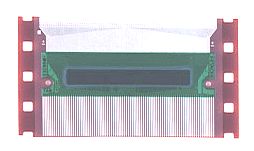|
Tokyo, June 7, 2001 --- Hitachi, Ltd. (TSE: 6501) today announced
the HD66353 TFT LCD driver offering 480 outputs and 256-grayscale
at an LCD drive voltage up to 16 V, as a data line driver for SXGA*1
and UXGA*2 size high-definition
TFT LCD panels with a wide viewing angle. Sample shipments will begin
on June 20, 2001 in Japan.
TFT LCD panels mounted in monitors, space-saving desktop PCs, and
notebook PCs, are becoming available in larger screen sizes and are
shifting high-definition from the XGA*3
to SXGA and UXGA. In addition, TFT LCD panels offering high display
quality together with a wide viewing angle have appeared on the market,
and are in increasing demand. However, TFT LCD panels offering a wide
viewing angle require a high LCD drive voltage, bringing a need for
an LCD driver capable of generating the necessary high voltage in
addition to supporting high-definition display.
Hitachi has previously released the 384-output, 256-grayscale HD66351,
with an LCD drive voltage of 14.5 to 15.5 V, and supporting the XGA
and SXGA, as a data line driver for TFT LCD panels with a wide viewing
angle, and is now extending the TFT driver lineup in response to market
demand with the release of the HD66353, offering 480-output and 256-grayscale
at an LCD drive voltage of 11 to 16 V, for use with SXGA and UXGA
panels.
The HD66353 operates over a wide LCD drive voltage range, from a maximum
of 16 V to a minimum of 11 V. The data line drive outputs, comprising
8-bit D/A converters and op-amps, accept 8-bit digital data per pixel
and generate voltages for 256-grayscale. The output voltage generation
circuitry employs Hitachi's original chopper type amplifiers, with
automatic cancellation of deviations in output voltage between frames,
enabling an output voltage precision of ± 2 mV to be achieved
despite the high 16 V voltage level. This makes it possible to achieve
an LCD panel offering a high-quality display with a wide viewing angle
and 16.77-million color display capability.
The 480 data line drive outputs are an ideal number for configuring
an SXGA or UXGA size screen. With the 480 outputs of the HD66353,
SXGA LCD panel data line drive can be handled by eight chips, and
UXGA by ten, compared with ten and 13 chips, respectively, in the
case of current 384-output devices. This enables the number of system
components to be reduced, and, with UXGA display in particular, makes
it possible to design an efficient LCD panel that uses all the pins,
in contrast to the inefficient situation with previous 384-output
and 192-output devices where some pins are not used.
The internal circuits operate at a low voltage of 2.3 V, and the interface
to external circuits such as an LCD drive timing controller has also
been made operable at 2.3 V as a CMOS interface, enabling overall
system voltage and power consumption to be reduced.
The HD66353 is available in a COF*4
or TCP*5 package.
Future plans call for further extension of the product lineup in line
with trends in the TFT LCD panel market.
Notes:
| 1. |
SXGA (Super Extended Graphics Array):
A display definition standard. The display comprises 1,280 × 1,024
dots. |
| 2. |
UXGA (Ultra Extended Graphics Array):
A display definition standard. The display comprises 1,600 × 1,200 dots. |
| 3. |
XGA (Extended Graphics Array): A display
definition standard. XGA is a trademark of IBM Corporation, indicating
a display comprising 1,024 × 768 dots. |
| 4. |
COF (Chip On Film): A package mounted
on an ultra- thin-film tape, allowing bending of 1 mm or less. |
| 5. |
TCP (Tape Carrier Package): A package
mounted on a thin-film tape, allowing ultra-thin type mounting
(1 mm or less) |

SXGA and UXGA TFT LCD panel (monitors, space-saving
desktop PCs, notebook PCs)



 |


